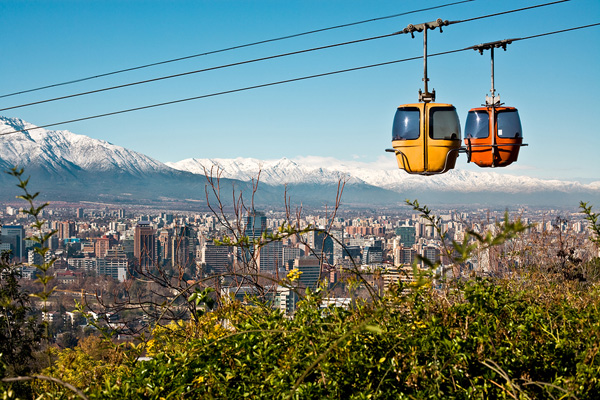Public Transportation in Santiago
Summary: Mastering the public transportation system in Santiago is a crucial aspect of adapting to life there. This article provides a detailed overview of the available local transit options.

Santiago, the capital city of Chile, is a bustling metropolis with a population of over 5 million people. The city is well-served by a variety of public transportation options, including the Metro de Santiago (subway), Transantiago buses, colectivos (shared taxis), and even bike-sharing programs. These systems are interconnected and can be accessed using a single payment card, the Bip! card. For an expat living in Santiago, it is entirely possible to live comfortably without a car, relying on these public transportation systems and walking.
Metro de Santiago
The Metro de Santiago is the backbone of Santiago's public transportation system. It is the second largest subway system in South America, with 7 lines and over 136 stations. The Metro is safe, clean, and efficient, making it a popular choice for both locals and expats. It operates from 5:30 AM to midnight, with increased frequency during rush hours. The cost of a ride varies depending on the time of day, ranging from 700 to 830 Chilean pesos (approximately 1 to 1.2 USD). The Metro is generally safe at all times of day, although like any large city, it's advisable to be aware of your surroundings and keep an eye on your belongings.
Transantiago Buses
Complementing the Metro system are the Transantiago buses. These buses cover a wider area than the Metro, reaching into the suburbs and areas not served by the subway. The buses run 24 hours a day, although service is less frequent during the night. The cost of a bus ride is slightly cheaper than the Metro, ranging from 640 to 760 pesos (approximately 0.9 to 1.1 USD). The buses are generally safe, but can be crowded during peak hours. It's also worth noting that the bus routes can be complex and confusing for newcomers, so it's a good idea to plan your route in advance using a map or a smartphone app.
Colectivos
Colectivos are shared taxis that follow fixed routes, similar to buses. They are a popular choice for short trips within the city, especially in areas not well-served by the Metro or buses. Colectivos can be hailed on the street, and the fare is usually around 700 pesos (approximately 1 USD). They are generally safe and reliable, although they can be a bit cramped as they often carry up to four passengers in addition to the driver.
Bike-Sharing Programs
For those who prefer a more active mode of transportation, Santiago offers several bike-sharing programs. The most popular of these is BikeSantiago, which has over 200 stations throughout the city. The cost of a monthly membership is 4,990 pesos (approximately 7 USD), which includes unlimited 30-minute rides. Additional time is charged at a rate of 500 pesos (approximately 0.7 USD) per half hour. The city has been investing in bike infrastructure in recent years, with a growing network of bike lanes making it safer and easier to get around by bike.
In conclusion, Santiago's public transportation system is comprehensive and affordable, making it entirely feasible to live in the city without a car. Whether you prefer the speed and efficiency of the Metro, the wide coverage of the buses, the convenience of colectivos, or the active lifestyle of biking, Santiago has you covered.
About the Author
 Joshua Wood, LPC joined Expat Exchange in 2000 and serves as one of its Co-Presidents. He is also one of the Founders of Digital Nomad Exchange. Prior to Expat Exchange, Joshua worked for NBC Cable (MSNBC and CNBC
Primetime). Joshua has a BA from Syracuse and a Master's in Clinical and Counseling Psychology from Fairleigh Dickinson University. Mr. Wood is also a licensed counselor and psychotherapist.
Joshua Wood, LPC joined Expat Exchange in 2000 and serves as one of its Co-Presidents. He is also one of the Founders of Digital Nomad Exchange. Prior to Expat Exchange, Joshua worked for NBC Cable (MSNBC and CNBC
Primetime). Joshua has a BA from Syracuse and a Master's in Clinical and Counseling Psychology from Fairleigh Dickinson University. Mr. Wood is also a licensed counselor and psychotherapist.
Some of Joshua's articles include Pros and Cons of Living in Portugal, 10 Best Places to Live in Ireland and Pros and Cons of Living in Uruguay. Connect with Joshua on LinkedIn.
Additional Information:
- Expat Guide to Santiago
- Health Care in Santiago
- The Insider's Guide to Santiago
- Healthcare & Health Insurance in Chile
- Best Places to Live in Chile
- Real Estate in Chile
- Pros & Cons of Living in Chile
- 10 Cultural Faux Pas to Avoid While Living in Chile
- Pros and Cons of Living in Chile 2025
- 2025 Guide to Moving to Chile



